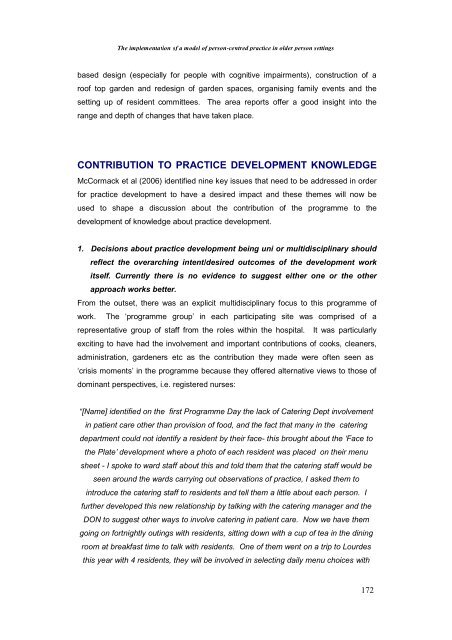The Implementation of a Model of Person-Centred Practice In Older ...
The Implementation of a Model of Person-Centred Practice In Older ...
The Implementation of a Model of Person-Centred Practice In Older ...
Create successful ePaper yourself
Turn your PDF publications into a flip-book with our unique Google optimized e-Paper software.
<strong>The</strong> implementation <strong>of</strong> a model <strong>of</strong> person-centred practice in older person settings<br />
based design (especially for people with cognitive impairments), construction <strong>of</strong> a<br />
ro<strong>of</strong> top garden and redesign <strong>of</strong> garden spaces, organising family events and the<br />
setting up <strong>of</strong> resident committees. <strong>The</strong> area reports <strong>of</strong>fer a good insight into the<br />
range and depth <strong>of</strong> changes that have taken place.<br />
CONTRIBUTION TO PRACTICE DEVELOPMENT KNOWLEDGE<br />
McCormack et al (2006) identified nine key issues that need to be addressed in order<br />
for practice development to have a desired impact and these themes will now be<br />
used to shape a discussion about the contribution <strong>of</strong> the programme to the<br />
development <strong>of</strong> knowledge about practice development.<br />
1. Decisions about practice development being uni or multidisciplinary should<br />
reflect the overarching intent/desired outcomes <strong>of</strong> the development work<br />
itself. Currently there is no evidence to suggest either one or the other<br />
approach works better.<br />
From the outset, there was an explicit multidisciplinary focus to this programme <strong>of</strong><br />
work. <strong>The</strong> ‘programme group’ in each participating site was comprised <strong>of</strong> a<br />
representative group <strong>of</strong> staff from the roles within the hospital. It was particularly<br />
exciting to have had the involvement and important contributions <strong>of</strong> cooks, cleaners,<br />
administration, gardeners etc as the contribution they made were <strong>of</strong>ten seen as<br />
‘crisis moments’ in the programme because they <strong>of</strong>fered alternative views to those <strong>of</strong><br />
dominant perspectives, i.e. registered nurses:<br />
“[Name] identified on the first Programme Day the lack <strong>of</strong> Catering Dept involvement<br />
in patient care other than provision <strong>of</strong> food, and the fact that many in the catering<br />
department could not identify a resident by their face- this brought about the ‘Face to<br />
the Plate’ development where a photo <strong>of</strong> each resident was placed on their menu<br />
sheet - I spoke to ward staff about this and told them that the catering staff would be<br />
seen around the wards carrying out observations <strong>of</strong> practice, I asked them to<br />
introduce the catering staff to residents and tell them a little about each person. I<br />
further developed this new relationship by talking with the catering manager and the<br />
DON to suggest other ways to involve catering in patient care. Now we have them<br />
going on fortnightly outings with residents, sitting down with a cup <strong>of</strong> tea in the dining<br />
room at breakfast time to talk with residents. One <strong>of</strong> them went on a trip to Lourdes<br />
this year with 4 residents, they will be involved in selecting daily menu choices with<br />
172
















